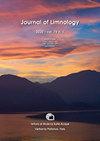洪水条件下湖泊水位波动的时间演变及其对沿海生态系统的影响
IF 1.1
4区 环境科学与生态学
Q4 LIMNOLOGY
引用次数: 2
摘要
湖泊水位的波动受季节变化、水资源管理和气候变化的制约。最近的研究表明,全球变暖可能会影响洪水的风险,而洪水事件的决定性因素不是温度,而是降水特征和水文条件。洪水事件对社会、经济和环境方面有许多影响,这取决于人类如何改变土地、自然河流和湖泊的动态。防洪措施可能与养护措施和生态系统服务产生冲突,因为人们不认为自然资本能够控制洪水并有助于控制洪水,而认为自然资本能够促进人类健康和安全。本文以1868-2021年为参考期,考虑近10年的洪水频率,对马焦雷湖的洪水事件进行了3 - 5 - 10 - 25 - 50 - 100 - 250 - 500年的回归周期分析。讨论了洪峰的概率分布、水位波动与大型无脊椎动物发生的相关性和线性回归。我们还绘制了湖岸洪水灾害图。较好地描述年峰值水平的概率分布是Gumbel函数,而对于春季和秋季洪水事件,较好的分布是Log-Pearson III型。历史上规模最大的一次洪水发生在2000年,其特征是50年才发生一次。上一次洪水事件发生在2020年,其特征是大约10年的复发期。从汛期频次来看,秋季汛期震级高于春季汛期,且汛期差异逐渐增大。结果表明,每三年发生一次洪水的可能性很大,并且预测每10年发生一次海拔约197米(高于平均湖面3.14米)的洪水。湖面升高会影响芦苇床面积,从193米到194.5米更有效(最多减少10%)。在洪水期间,整个芦苇床区域被淹没。对于大型无脊椎动物的组成和丰度,第一个结果表明,所有采样站的水位与Cladotanytarsus sp. (Chironominae)的丰度呈显著负相关,而Magadino的水位与Pscectrocladius sordidellus (Orthocladiinae)的丰度呈近显著正相关。这几个结果可能是由于目前有限的数据可用性。本文章由计算机程序翻译,如有差异,请以英文原文为准。
Temporal evolution of lake level fluctuations under flood conditions and impacts on the littoral ecosystems
Lake levels fluctuations are conditioned by seasonal variability, water resources management and climate change. Recent studies have shown that global warming potentially affects the risk of flooding and that the decisive factor for flood events is not temperature, but precipitation characteristics and hydrological conditions. Flood events have numerous impacts on social, economic and environmental aspects depending on how humans have altered lands, natural rivers and lake dynamics. Flood protection measures can cause conflicts with conservation measures and with ecosystem services because natural capital is not considered able to control floods and to contribute control floods and that it can contribute to human health and safety. In this paper we analysed the flood events in Lake Maggiore for return time periods of 3 – 5 – 10 – 25 – 50 – 100 – 250 – 500 years, considering the flood frequency in the last ten years using 1868-2021 as a reference period. We discussed the probability distribution of flood peaks, the correlation and linear regression between the lake level fluctuations and macroinvertebrates occurrence. We also presented lake coasts flood hazard mapping. The probability distribution that better describes the annual peak level is the Gumbel function, while for spring and autumn flood events the better distribution is the Log-Pearson type III. One of the historical flood events in terms of magnitude was in 2000, characterized by a return time of about 50 years. The last flood event in 2020, was characterized by a return period of about 10 years. Considering the seasonal frequency of flood, the autumn magnitude was higher than the spring one, and the differences between seasonal flood events progressively increased. The results suggested a high probability of a flood event every three years and also a forecast of a flood of about 197 m asl (3.14 m above the average lake level) every 10 years. Raising the lake level will affect the reed bed area from 193 m asl, and it will be more effective at 194.5 m (up to a 10% reduction). During flood events, the whole reed bed area is submerged. As regard macroinvertebrates composition and abundance, the first results show significant negative relationships between all sampling stations altogether vs the abundance of Cladotanytarsus sp. (Chironominae) and nearly significant positive relationships between water levels at Magadino vs Pscectrocladius sordidellus (Orthocladiinae) abundances. These few results are perhaps due to the current limited data availability.
求助全文
通过发布文献求助,成功后即可免费获取论文全文。
去求助
来源期刊

Journal of Limnology
地学-湖沼学
CiteScore
2.70
自引率
6.20%
发文量
12
审稿时长
3 months
期刊介绍:
The Journal of Limnology publishes peer-reviewed original papers, review papers and notes about all aspects of limnology. The scope of the Journal of Limnology comprises the ecology, biology, microbiology, physics, and chemistry of freshwaters, including the impact of human activities, management and conservation. Coverage includes molecular-, organism-, community-, and ecosystem-level studies on both applied and theoretical issues. Proceedings of workshops, specialized symposia, conferences, may also be accepted for publication.
 求助内容:
求助内容: 应助结果提醒方式:
应助结果提醒方式:


